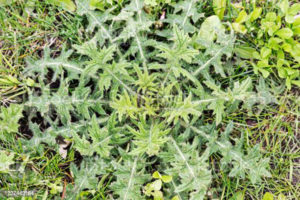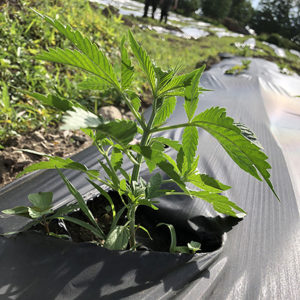Here they come!

Broadleaf Thistle weed.
You know what we mean … those weeds. They’ve been lying in wait to make their annual assault on
your hemp grow. There are plenty of things you can do, though, to help keep them at bay and make
sure your new plants thrive to maturity.
Of course, weeds vary from climate to climate. The thistle and purslane we deal with here in arid, high-
altitude Colorado are different from the species that plague our crops from Mississippi to Maine to
Montana. Still there are some basic best practices that are nearly universal for weed control.

“Milk thistle”
Your most important first step: know your enemy! By observation and research, you can understand
which weed varieties are most common in your area. Your county extension office or state department
of agriculture can help you with identification. Since chemical herbicides are pretty much not an option
for us hemp growers, we need to work smart to suppress or eliminate weeds before they become an
overwhelming problem. Working smart means building your knowledge base about the specific weed
varieties you will contend with.
Hopefully, you started the season out by right-sizing your rows. If you use a mechanical cultivator, your
rows should be set just wide enough to accommodate it. Many of you rely on hand cultivation, using
people-powered tools to keep pathways and root zones clear. This is probably one of the more
expensive options available in most places, but an undeniably effective method.
We note that significant numbers of hemp farmers are trying raised beds and plastic mulch with drip
irrigation run underneath, or biodegradable film that can be tilled back into the soil after harvest. These
two methods control weeds around the plants, but still leaves some work to be done in the walkways.

With regard to walkways, some of you have found success by covering them with forage or hay to
suppress weeds. Others use low-growing ground cover such as clover for the same effect. Or, you might
be growing tight rows so the tall plants eventually create a canopy that will shade out any invaders along
the path.
However you deal with your weeds, make sure your row spacing at the beginning of the season is
optimized for your specific process. Also, sticking to a consistent process for continuous weeding
throughout the season is essential. Yanking weeds when they still have only tiny thread roots means
they are easier to eradicate and less likely to disturb hemp roots when removed.
After the harvest, there are still weed control measures you can do into the next planting season. The
first is to plant a winter ground cover that will enrich the soil and help choke out unwanted varieties.
Another excellent strategy is crop rotation to disrupt the weed growing cycles.
So, what methods have you tried? What has worked best for you? We’d love to hear about your
experience! Drop us a message here: https://cheyennemountainseedcompany.com/contact-us/
To all our hemp growing friends and family: we hope you have a great, successful summer! All the best
from your team at Cheyenne Mountain Seed Company!


Recent Comments